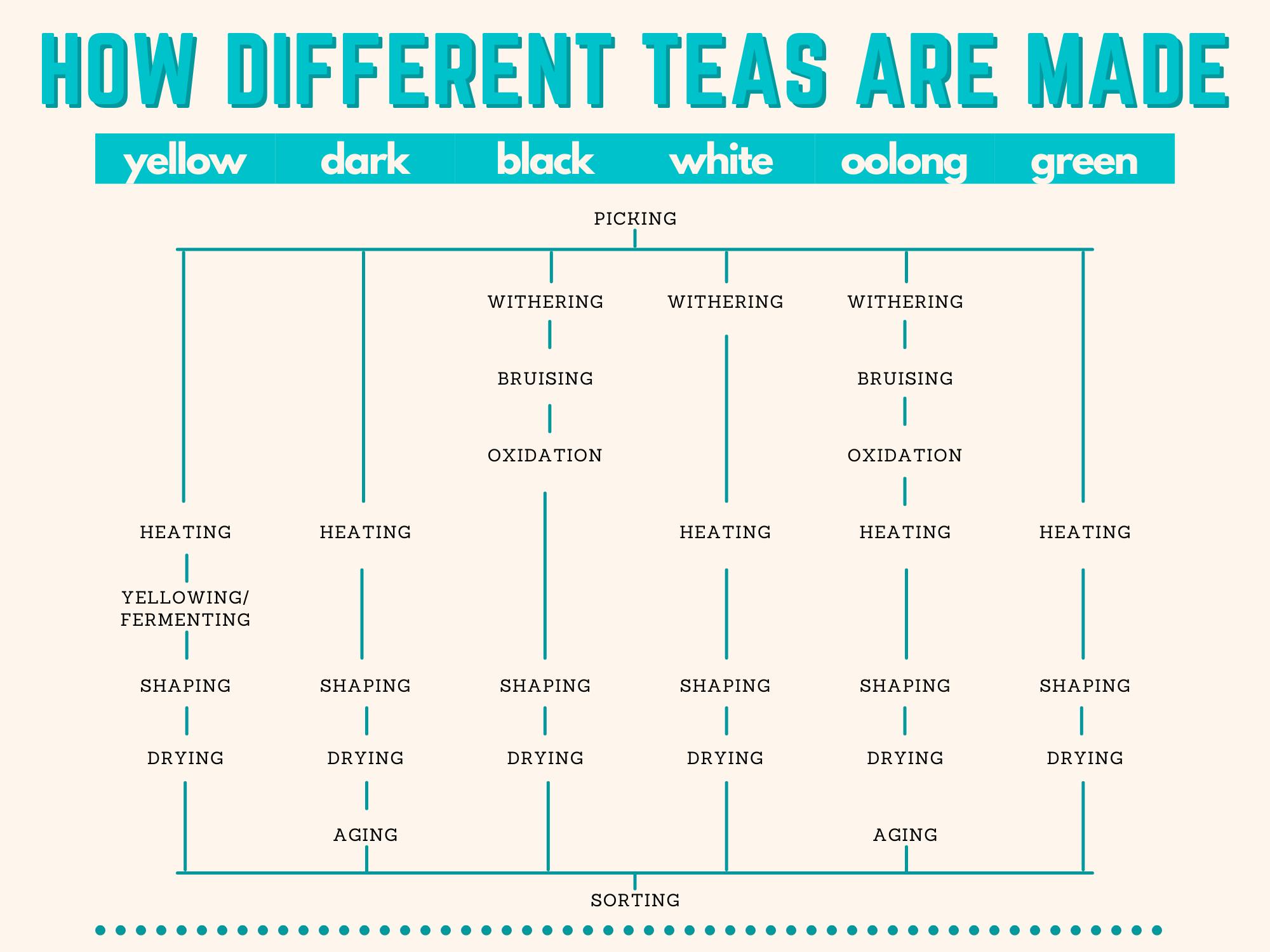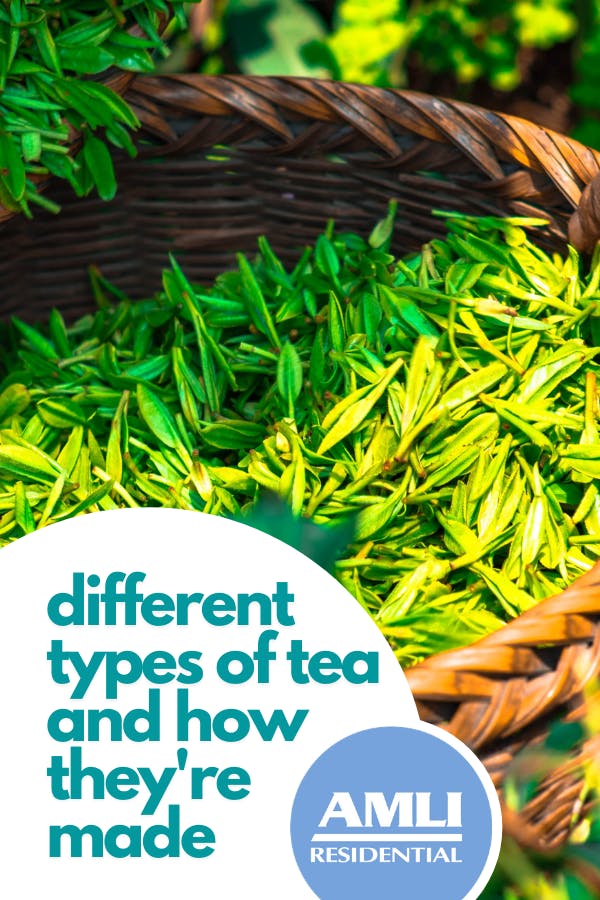Ever wondered what the difference is between green tea, black tea or oolong tea?
It turns out that all these leaves go through a similar process on their journey from bush to kettle, with just a few detours.

Different teas and how they’re made
How tea is made
Although there are about as many tea blends as there are tea-drinkers in the world, nearly all types of tea come from just one kind of plant! The leaves of the Camellia sinensis plant are processed in different ways to give us variants like green tea, black tea, white tea and more, and that process is what can change the strength, caffeine levels and color of the final drink.
In order to understand why the variants are different, it’s important to know the entire tea production process from start to finish!
Plucking
The first step, of course, is to pluck the leaves from the tea bush. Depending on the type of tea being made, this step can take place while the leaves are anywhere from very young to very mature.
Withering
As with any freshly-plucked leaves, they will start to wither not long after being separated from the live bush. This step allows any remaining moisture trapped in the leaf to evaporate, which is usually done by drying the leaves under the sun (for darker teas) or in a well-ventilated room (for lighter teas).
Bruising
From here, the leaves are exposed to different levels of oxidation (exposure to the air that makes the leaves darker) depending on the type of tea. Bruising the leaves by shaking, rolling, tossing or crushing them allows the inner structure of the leaf to break down and interact with the air, quickening the oxidation process and releasing oils, which may change the flavor profile of the tea.
Oxidation
Some teas require anything from 70-100% oxidation, such as black or darker oolong teas. These leaves are left in a large, dry room to oxidize until they reach the desired levels of darkness.
Fixation
Once the leaves are properly oxidized, the leaves are gently heated to kill any oxidative enzymes left in the leaves. This stops the leaves from being over-oxidized, which can leave the tea tasting grassy and fermented.
Yellowing
For yellow teas (which we’ll talk about more in a bit), the tea leaves are subjected to light heating in a closed bin, turning the leaves yellow due to the transformation of the amino acids in the tea.
Shaping/rolling
The heated tea leaves, which become slightly damp during the heating process, are then shaped into rolls, tubes, spirals, cones or pellets, depending on the type of tea and the preference of the producer. In ancient times, the leaves used to be pressed into bricks for easier transportation.
Drying
The last drying step is vital for the sale and production of tea. This is done by sun-drying, baking or air drying, and it’s important to not over-dry the leaves or else the tea will taste bitter and burnt.
Fermentation
Some teas require an additional step of aging, or fermentation, to add sweetness to naturally bitter leaves. Flavored teas like Pu-erh and oolong teas benefit greatly from this step, and additional flavors are often fermented with the leaves to add the extra taste.
Sorting
This is the last stage before the tea is packaged. Here, the stems, seeds and impurities are sorted out from the final tea leaves, as well as any burnt or discolored leaves.
The different kinds of teas
Now that we know the tea-making process, we can understand what makes different types of tea, well, different!
White tea
White tea is the least-processed of all teas. The leaves are picked at a very early stage while the buds are still young and have a distinct white color. White tea leaves are withered for a long time and bypass the oxidation and fixation processes entirely. The leaves are dried as-is, which preserves the mild, gentle flavor of the tea.
Green tea
Green tea leaves undergo the least amount of oxidation of all teas, as oxidation removes much of the chlorophyll from the leaves. Green tea leaves are heated almost immediately after being picked, preserving the green color and the fresh taste.
Yellow tea
As mentioned above, yellow tea leaves are subjected to a fermentation process before being dried. This process gives the leaves a yellowish-greenish color while still preserving the strength of an oxidized tea.
Oolong
This type of tea has the most complex process of all teas. The process is similar to that of green and black teas, but oolong tea leaves have a slow, controlled oxidation process done by withering, bruising and resting the leaves.
Black tea
Black tea leaves are intended to oxidize completely, giving the tea a bolder, stronger taste than other types. After being plucked, the leaves are immediately withered to remove as much of the water as possible. The leaves are then bruised and rolled to release the tannins and oils trapped inside before being completely oxidized.
Dark tea
These dark teas (also called post-fermented teas) undergo a similar process as black teas, but these leaves are fermented after being heated and shaped. Some dark tea varieties, such as Pu-erh, can ferment for up to 50 years without losing its quality, and these are usually sold for a much higher price. Another famous version of dark, fermented tea is kombucha!
How to drink your tea
Now that you know your teas and how they’re made, you can brew the perfect cup of tea! Make sure you also use this tea-brewing chart to find out how long and how hot to brew your tea.
Pin it!

Featured photo courtesy Pixabay/highnesser


 View All Posts by Colleen Ford
View All Posts by Colleen Ford